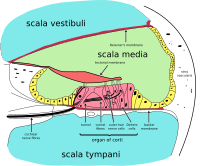
Photo from wikipedia
Although human bone conduction (BC) hearing is well investigated, there is a lack of information about BC hearing in most other species. In humans, the amount of conductive loss is… Click to show full abstract
Although human bone conduction (BC) hearing is well investigated, there is a lack of information about BC hearing in most other species. In humans, the amount of conductive loss is estimated as the difference between the air conduction (AC) and BC thresholds. Similar estimations for animals are difficult since in most species, the normal BC hearing thresholds have not been established. In the current study, the normal BC thresholds in the frequency range between 2 kHz and 20 kHz are investigated for the Guinea pig. Also, the effect of a middle ear lesion, here modelled by severing the ossicles (ossicular discontinuity) and gluing the ossicles to the bone (otosclerosis), is investigated for both AC and BC. The hearing thresholds in the Guinea pigs were estimated by a regression of the amplitude of the compound action potential (CAP) with stimulation level and was found robust and gave a high resolution of the threshold level. The reference for the BC thresholds was the cochlear promontory bone velocity. This reference enables comparison of BC hearing in animals, both intra and inter species, which is independent on the vibrator and stimulation position. The vibration was measured in three orthogonal directions where the dominating vibration directions was in line with the stimulation direction, here the ventral direction. The BC thresholds lay between -10 and 3 dB re 1 μm/s. The slopes of CAP growth function were similar for AC and BC at low and high frequencies, but slightly lower for BC than AC at frequencies between 8 and 16 kHz. This was attributed to differences in the stimulus levels used for the slope estimation and not a real difference in CAP slopes between the stimulation modalities. Two kinds of middle ear lesions, ossicular discontinuity and stapes glued to the surrounding bone, gave threshold shifts of between 23 and 53 dB for AC while it was below 16 dB when the stimulation was by BC. Statistically different threshold shifts between the two types of lesions were found where the AC threshold shifts for a glued stapes at 2 and 4 kHz were 9-18 dB greater than for a severed ossicular chain, and the BC threshold shifts for a glued stapes at 4 and 12 kHz were 8-9 dB greater than for a severed ossicular chain.
Journal Title: Hearing Research
Year Published: 2019
Link to full text (if available)
Share on Social Media: Sign Up to like & get
recommendations!